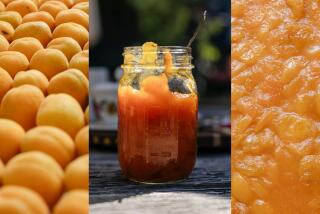The first rule of making great jams and jellies? Use great fruit
- Share via
Ernest Miller, who teaches canning and preserving, is an encyclopedia on the topic. Among the many things he told us while we made our first jam and jelly: Some pomegranate trees in California likely date to the days of the mission priests; pectin is a carbohydrate that makes apples crunchy; the word marmalade comes from the word for quince in Portuguese; and jam was first made in Roman times.
We made pomegranate jelly (made from juice, should be translucent) and plum jam (jelly with fruit pieces) in my third class of 12 on canning and preserving -- which I joined as a new empty-nester. It’s held Wednesdays in the cafe near the Hollywood farmers market called the Farmer’s Kitchen.
The recipes are straightforward and approved by the U.S. Department of Agriculture for safety. Miller is drumming into us to follow the rules to make sure what we can and preserve is safe. That means paying attention to water baths, the right temperatures, good seals on our jars.
And there are some tricks, of course. The first one is great fruit. If you start out with fruit that doesn’t have a lot of taste, you might be able to improve it some, perhaps with lemon juice or spices. But only some. Our jam was made with heavenly friar plums from the Yingst Ranch in Littlerock, Calif. Six pounds of plums, with 8 cups of sugar, made about a dozen half-pint jars of jam.
The pomegranates came from Ojai, and I learned that the seed plus that red juicy covering is called an aril.
All our recipes call for fruit, sugar, pectin (though sometimes the pectin is naturally in the fruit) and an acid. For the jelly, we made some with commercial pectin and some with pectin we made ourselves the previous week, using apple scraps. It’s easy: Just cook the scraps in water for half an hour and boil down the liquid. But it’s not as reliable as commercial pectin, and you need a lot of apple scraps: 3 pounds for 2 cups of pectin.
Last week we “canned” (in Mason jars) several versions of apple slices -- in juices, syrups and just water. This week, we tasted them. They were generally good, though we mostly thought we’d overcooked the apples. But we also learned that some sugar helps; the ones in water were pretty dull.
Miller reminded me of Julia Child, who said cooks should never apologize for their food. He told us to repeat these responses aloud and use them whenever anyone questions our products: “I meant to do that. That’s the way it’s supposed to be.”
I hope I don’t need them.
The course is a project of the nonprofit Food Forward and its Can It! Academy. It runs for 12 weeks, but Food Forward also offers shorter courses; check the website.
ALSO:
Canning master Kevin West at the Hammer
More to Read
Eat your way across L.A.
Get our weekly Tasting Notes newsletter for reviews, news and more.
You may occasionally receive promotional content from the Los Angeles Times.











